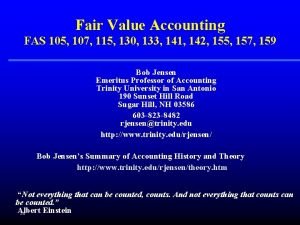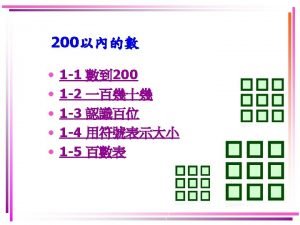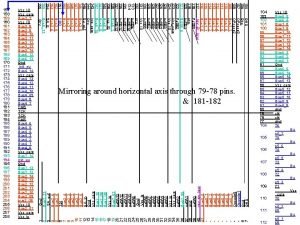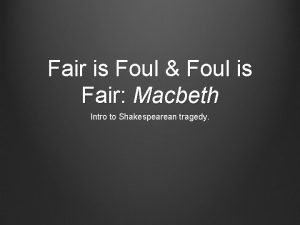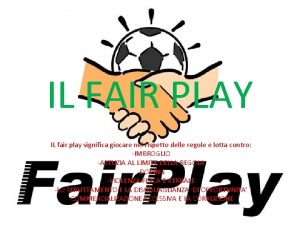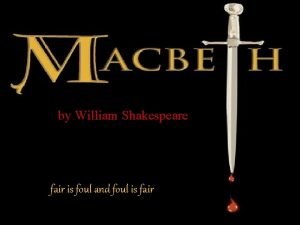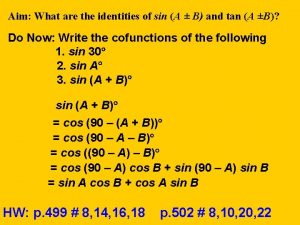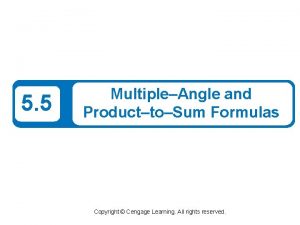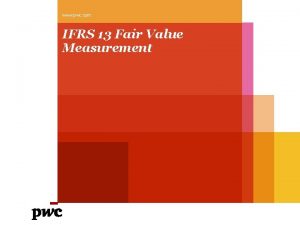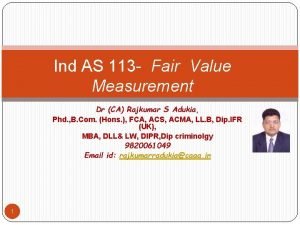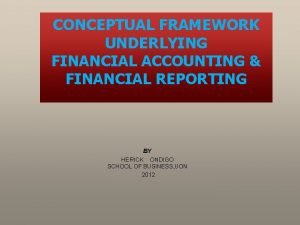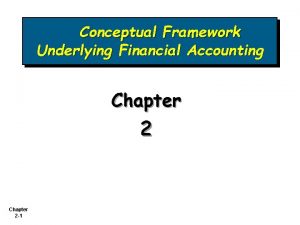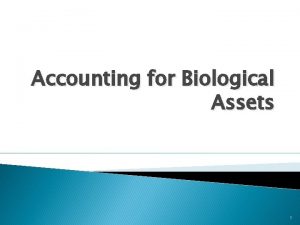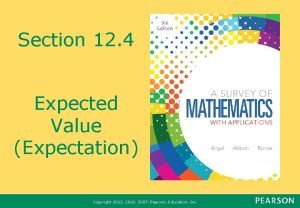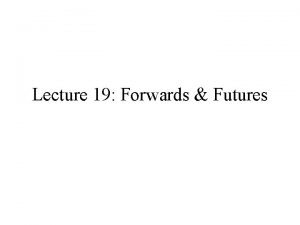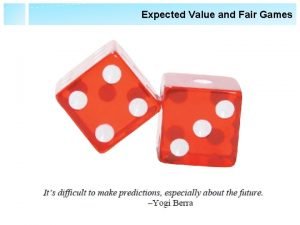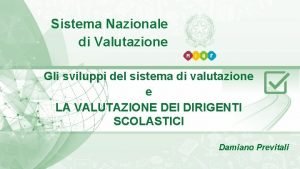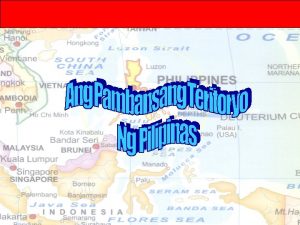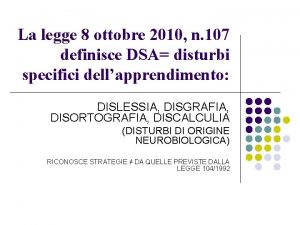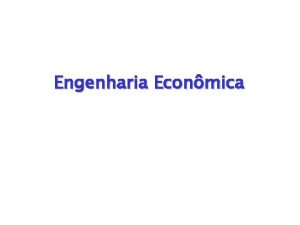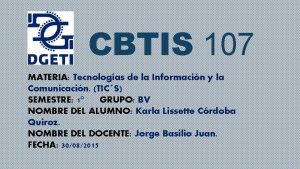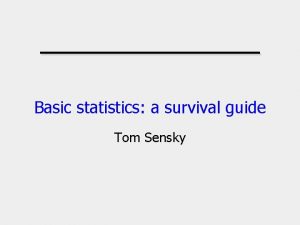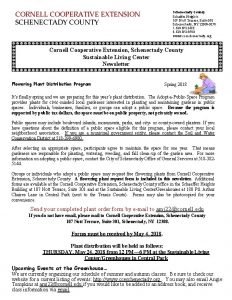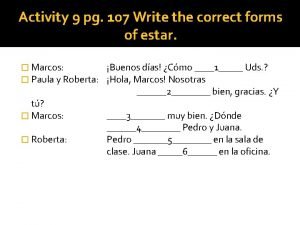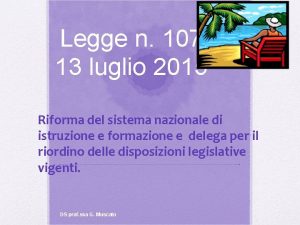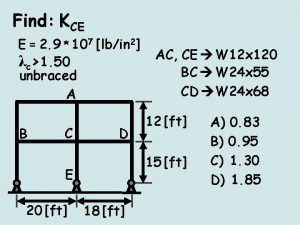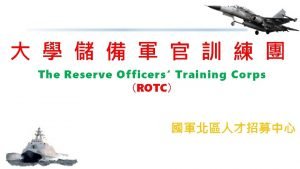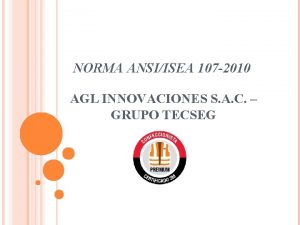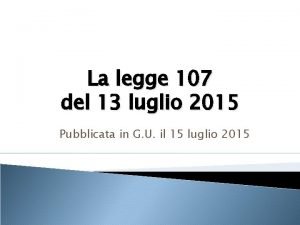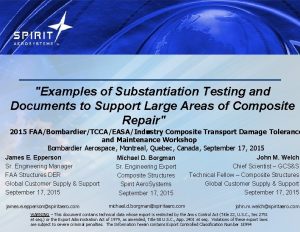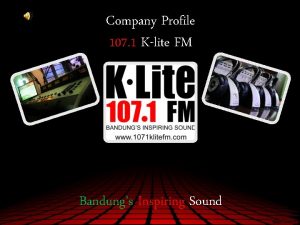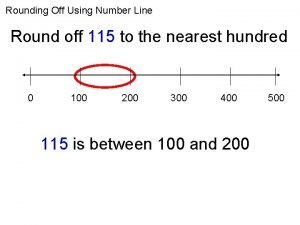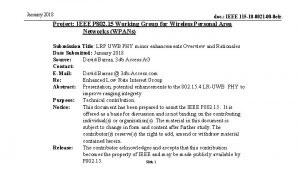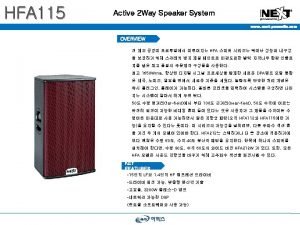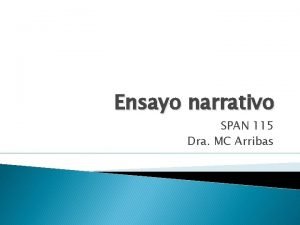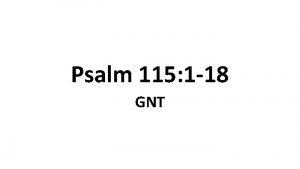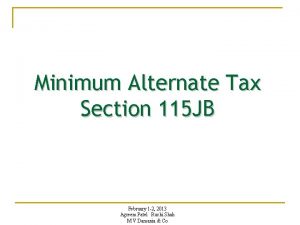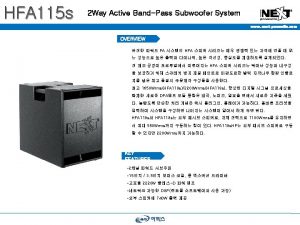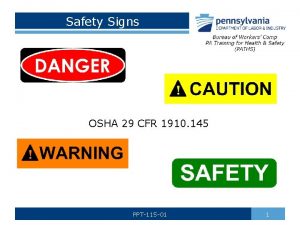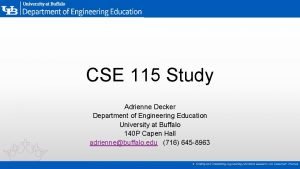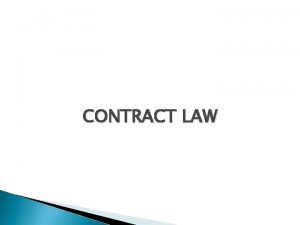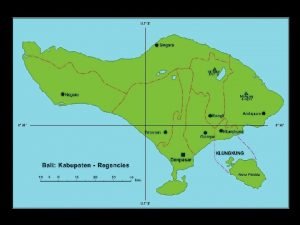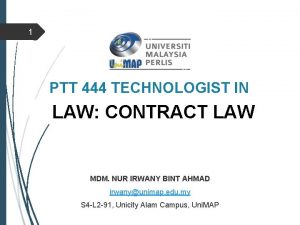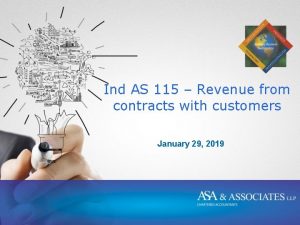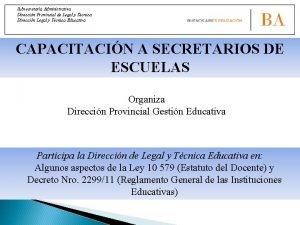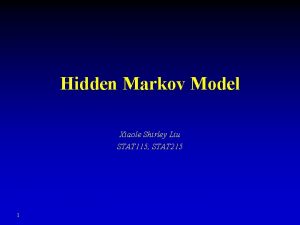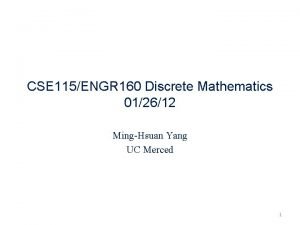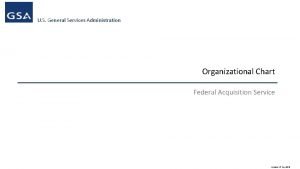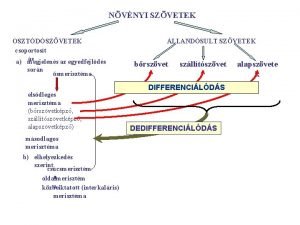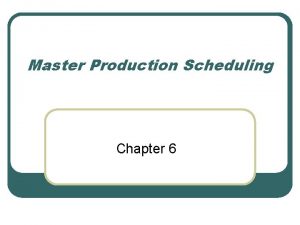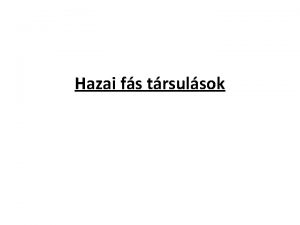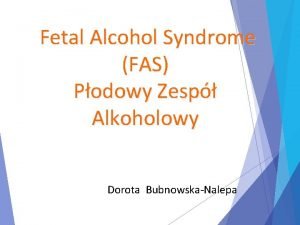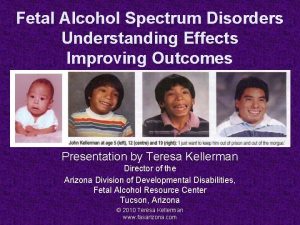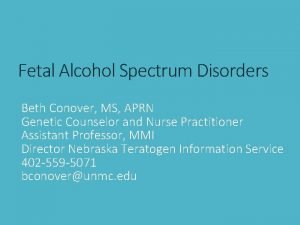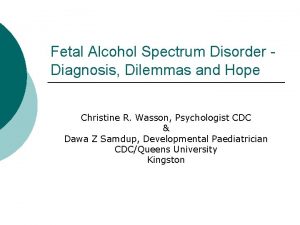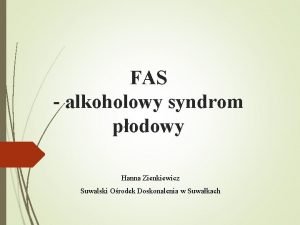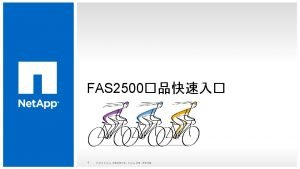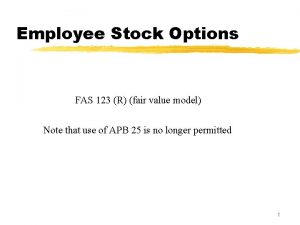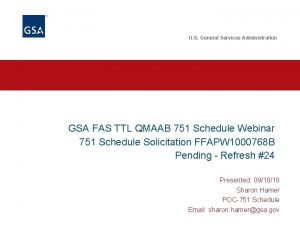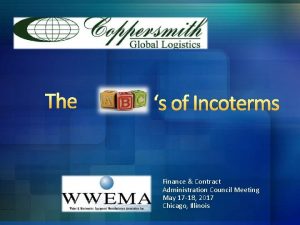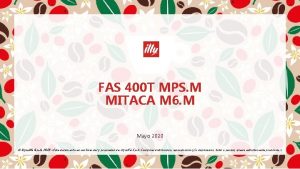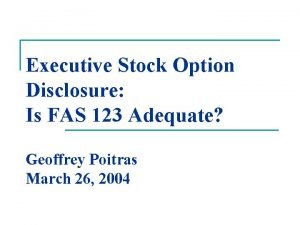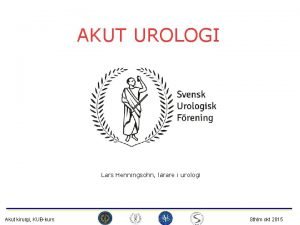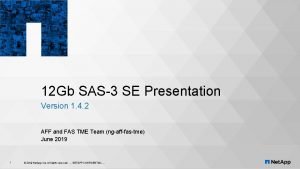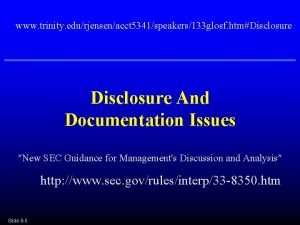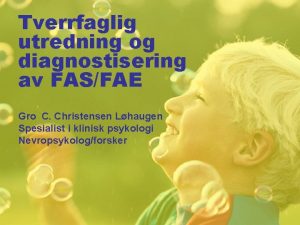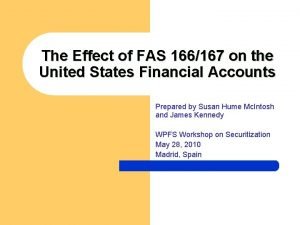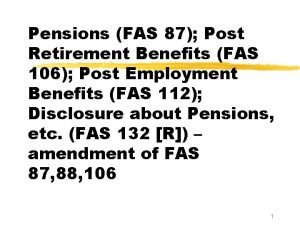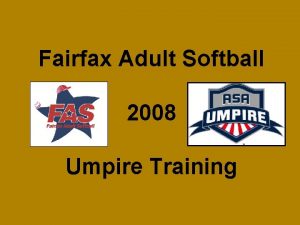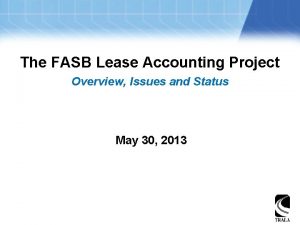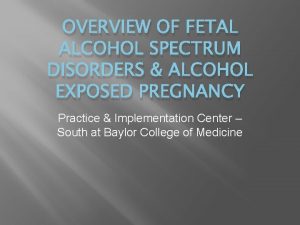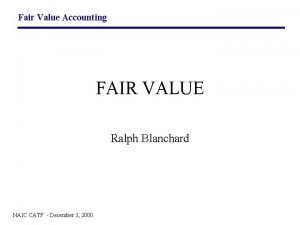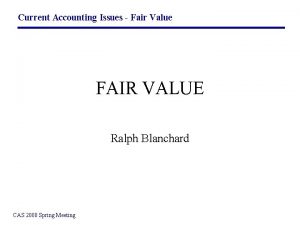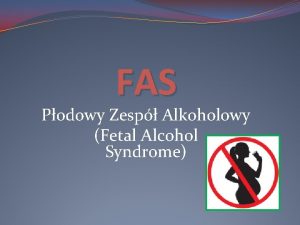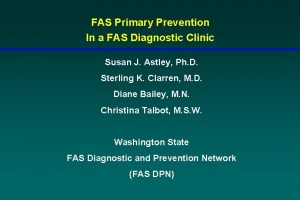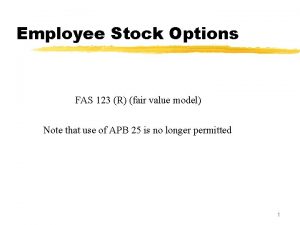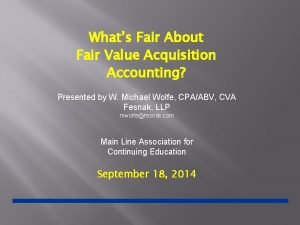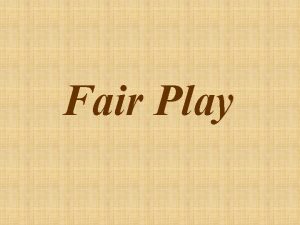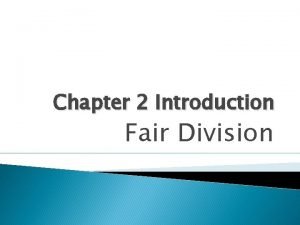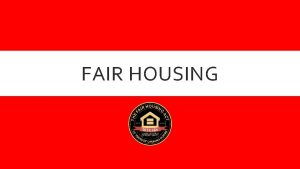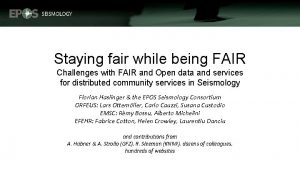Fair Value Accounting FAS 105 107 115 130




















































































































- Slides: 116

Fair Value Accounting FAS 105, 107, 115, 130, 133, 141, 142, 155, 157, 159 Bob Jensen Emeritus Professor of Accounting Trinity University in San Antonio 190 Sunset Hill Road Sugar Hill, NH 03586 603 -823 -8482 rjensen@trinity. edu http: //www. trinity. edu/rjensen/ Bob Jensen’s Summary of Accounting History and Theory http: //www. trinity. edu/rjensen/theory. htm “Not everything that can be counted, counts. And not everything that counts can be counted. ” Albert Einstein 1 -0

1 -1

1 -2

1 -3

1 -4

1 -5

1 -6

The government gave them 105% for their $200, 000 subprime mortgage. They then sold the house for $37, 000, got married, and are escaping from California. 1 -7

So are we now that we flipped the doghouse! 1 -8

Alternative Accounting Measures of Value of Assets and Liabilities “Skate to where the puck is going, not to where it is. ” Wayne Gretsky (as quoted for many years by Jerry Trites ) Historical Cost of Individual Assets and Liabilities Summed in Balance Sheet (Book Value) Historical Cost With Price Level Adjustments (PLA) Entry Value (Replacement Cost, Current Cost) 1 -9

Alternative Accounting Measures of Value of Assets and Liabilities “Skate to where the puck is going, not to where it is. ” Wayne Gretsky (as quoted for many years by Jerry Trites ) Exit Value (Net Liquidation Value) Economic Value (Discounted Cash Flows, FCF, Residual Income) Market Value of Entire Firm (Cash Versus Stock Trade) Market Value of All Shares Outstanding 1 -10

1 -11

FAS 33 from 1979 -1984 (ended with FAS 82) 1 -12

In 2007 International Harmonization is Becoming a Reality n In Year 2008 foreign corporations may file reports with the SEC and be listed on U. S. stock exchanges using IASB standards rather than FASB standards without reconciling the two. n The U. S. , Canada, and other nations are working toward adoption of IASB standards in place of domestic accounting standards. 1 -13

Fair Value Accounting Under the IASB & FASB n IASB is exploring, with FASB input, overhaul of fair-value accounting as part of a wider project on measurement. It is in the context of this long-planned effort, and not some recent reaction, that the IASB is planning to and will explore issues related to fair-value accounting. n IAS 32 and 39 Require Fair Value Accounting for Financial Instruments in Many Instances 1 -14

Alternative Accounting Measures of Value of Assets and Liabilities Skate to where the puck is going, not to where it is. Wayne Gretsky (as quoted for many years by Jerry Trites ) Graduate student Derek Panchuk and professor Joan Vickers, who discovered the Quiet Eye phenomenon, have just completed the most comprehensive, onice hockey study to determine where elite goalies focus their eyes in order to make a save. Simply put, they found that goalies should keep their eyes on the puck. In an article to be published in the journal Human Movement Science, Panchuk and Vickers discovered that the best goaltenders rest their gaze directly on the puck and shooter's stick almost a full second before the shot is released. When they do that they make the save over 75 per cent of the time. "Keep your eyes on the puck, " Phys. Org, October 26, 2006 --http: //physorg. com/news 81068530. html Investors want us to give them a puck to focus on at all times. 1 -15

Fair Value Accounting Under the IASB & FASB The main problem of fair value adjustment is that many (most? ) of the adjustments cause enormous fluctuations in earnings, assets, and liabilities that are washed out over time and never realized. The main advantage is that interim impacts that “might be” realized are booked. It’s a war between “might be” versus “might never. ” The war has been waging for over a century with respect to booked assets and two decades with respect to unbooked derivative instruments, contingencies, and intangibles. 1 -16

1 -17

Fair Value Accounting Under the IASB & FASB n Holder, Hopkins, and Wablen (The Accounting Review, 2004, pp. 453 -472) found, in a sample of 200 banks, that fair value accounting gave rise to more than five times more earnings volatility than traditional GAAP earnings. n Much of the volatilty washes out over time such that earnings increases and decreases from fair value adjustments have zero effect on cash in most instances. This is misleading for going concerns. 1 -18

Paragraph 15 of FAS 157 15. A fair value measurement assumes that the liability is transferred to a market participant at the measurement date (the liability to the counterparty continues; it is not settled) and that the nonperformance risk relating to that liability is the same before and after its transfer. Nonperformance risk refers to the risk that the obligation will not be fulfilled and affects the value at which the liability is transferred. Therefore, the fair value of the liability shall reflect the nonperformance risk relating to that liability. Nonperformance risk includes but may not be limited to the reporting entity’s own credit risk. The reporting entity shall consider the effect of its credit risk (credit standing) on the fair value of the liability in all periods in which the liability is measured at fair value. That effect may differ depending on the liability, for example, whether the liability is an obligation to deliver cash (a financial liability) or an obligation to deliver goods or services (a nonfinancial liability), and the terms of credit enhancements related to the liability, if any. 1 -19

Credit Spread In finance, a credit spread is the yield spread, or difference in yield between different securities, due to different credit quality. The credit spread reflects the additional net yield an investor can earn from a security with more credit risk relative to one with less credit risk. The credit spread of a particular security is often quoted in relation to the yield on a credit risk-free benchmark security or reference rate. There are several measures of credit spread, including Zspread and option-adjusted spread. 1 -20

Morgan Stanley Illustration First Quarter on 2009 n Reduced credit spread on a bond investment ceteris paribus increases market value of a bond and, thereby, results higher unrealized earnings due to mark-to-market upward adjustment of an asset. Reduced credit spread on a liability has the opposite impact on earnings for the unrealized loss due to a mark-to-market adjustment that increases the fair value of the liability. This is a bit confusing, since by reducing credit risk on their debt, debtors take an earnings hit when adjusting the debt to fair value. n Morgan Stanley took a $1. 5 billion hit in earnings due to improving its credit rating. 1 -21

Fair Valuing Debt Better/Worse Credit Standing = Loss/Gain Barge (James Barge, senior vice president and controller for Time Warner) also cited as problematic the hypothetical case of a company whose creditworthiness is downgraded by the rating agencies. By marking down the debt's value on its balance sheet, the company would realize more income, a scenario Barge called "nonsensical. " He warned of a host of such effects arising under fair value when a company changes its capital structure. 1 -22

Collatateralized Debt Obligation (CDO) (CDOs) are a type of structured asset-backed security (ABS) whose value and payments are derived from a portfolio of fixed-income underlying assets. CDOs are assigned different risk classes, or tranches, whereby "senior" tranches are considered the safest securities. Interest and principal payments are made in order of seniority, so that junior tranches offer higher coupon payments (and interest rates) or lower prices to compensate for additional default risk. 1 -23

David Li’s Gaussian Copula Function For five years, David Li's formula, known as a Gaussian Copula Function, looked like an unambiguously positive breakthrough, a piece of financial technology that allowed hugely complex risks to be modeled with more ease and accuracy than ever before. With his brilliant spark of mathematical legerdemain, Li made it possible for traders to sell vast quantities of new securities, expanding financial markets to unimaginable levels. His method was adopted by everybody from bond investors and Wall Street banks to ratings agencies and regulators. And it became so deeply entrenched—and was making people so much money—that warnings about its limitations were largely ignored. 1 -24

Key FASB Standards on Fair Value Acctg. n FAS 105 --- Disclosure of OBSF and market risks of instruments n FAS 107 --- Requirements for disclosure of FV n FAS 115 --- HTM vs. AFS vs. Trading n FAS 124 --- Investments Held by Not-for-Profit Orgs n FAS 130 --- OCI offset instead of current earnings n FAS 133 --- FV required for derivative instruments n FAS 141 --- Identify and FV intangibles in acquisitions n FAS 142 --- Must est. FV of “Goodwill” remaining n FAS 155 --- Requires FV acctg. for hybrid securities n FAS 157 --- Defines FV and hierarchy of meas. pref. n FAS 159 --- FVO for financial instruments 1 -25

"How to Save the Financial System, " by William M. Isaac, The Wall Street Journal, September 19, 2008 n Suspend the Fair Value Accounting rules “Biggest culprit for banking collapse” is FAS 115 that in bad times requires markdowns to “fire sale” values n Clamp down on abuses by short sellers Short sellers are engaged in abuses such as purchasing credit default swaps on corporate bonds (essentially bets on whether a borrower will default) n Withdraw the Basel II capital rules (2007) Allow high leverage capital ratios in good times, but require much higher ratios for banks losing money. 1 -26

Markowitz Portfolio Diversification Theory 1 -27

Shredded Mortgages Among CDO Bonds 1 -28

Coopula Formula Ignored Homeowner Default Covariances The reason that ratings agencies and investors felt so safe with the triple-A tranches was that they believed there was no way hundreds of homeowners would all default on their loans at the same time. One person might lose his job, another might fall ill. But those are individual calamities that don't affect the mortgage pool much as a whole: Everybody else is still making their payments on time. But not all calamities are individual, and tranching still hadn't solved all the problems of mortgage-pool risk. Some things, like falling house prices, affect a large number of people at once. If home values in your neighborhood decline and you lose some of your equity, there's a good chance your neighbors will lose theirs as well. If, as a result, you default on your mortgage, there's a higher probability they will default, too. That's called correlation—the degree to which one variable moves in line with another— and measuring it is an important part of determining how risky mortgage bonds are. “ “There it is again, the Invisible Hand giving us the finger. ” New Yorker Cartoon 1 -29

Shredded Mortgages Among CDO Bonds Too Much Confetti Turned Toxic Simultaneiously 1 -30

CDO Rating Downgrades From 2003 to 2006, new issues of CDOs backed by asset-backed and mortgage-backed securities had increasing exposure to subprime mortgage bonds. Mezzanine ABS CDOs are mainly backed by the BBB or lower-rated tranches of mortgage bonds, and in 2006, $200 billion in mezzanine ABS CDOs were issued with an average exposure to subprime bonds of 70%. As delinquencies and defaults on subprime mortgages occur, CDOs backed by significant mezzanine subprime collateral experience severe rating downgrades and possibly future losses. 1 -31

Difficulty in Pricing CDO Investments + Collateral Calls As the mortgages underlying the CDO's collateral decline in value, banks and investment funds holding CDOs face difficulty in assigning a precise price to their CDO holdings. Many are recording their CDO assets at par due to the difficulty in pricing. The pricing challenge arises because CDOs do not actively trade and mortgage defaults take time to lead to CDO losses. However, in June 2007, two hedge funds managed by Bear Stearns Asset Management Inc. faced cash or collateral calls from lenders that had accepted CDOs backed by subprime loans as loan collateral. The now defunct Bear Stearns, at that time the fifth-largest U. S. securities firm, said July 18, 2007 that investors in its two failed hedge funds will get little if any money back after "unprecedented declines" in the value of securities used to bet on subprime mortgages. 1 -32

. Statement 157 – Valuation Hierarchy Fair Value Hierarchy Level 3 Level 1 Level 2 Market- based Extrapolate Objective 1 -33 Income/FCF Model Subjective

AIG Insured Billions of Dollars in CDO Bonds With Credit Default Swaps (CDSs) Many investors (like Goldman Sachs) insured CDO investments against credit default with AIG CDOs. Unlike real insurance, AIG did not have to have adequate capital reserves to back up CDOs. Hank Paulson’s hidden agenda. 1 -34

But Most Banks Holding Toxic CDOs Were Not Insured with Credit Derivatives Well over a trillion dollars invested in CDO bonds sit on troubled banks balance sheet. No active markets until Geitner’s Plan creates a market. No quoted prices for valuation purposes. Inputs other than quoted prices are not observable from due to varying credit risks and volatile default rates. 1 -35

Former FDIC Chief William Isaac: Fair Value Caused the Crisis So say bankers, Isaac, Stever Forbes, & Buffett The devastation that followed stemmed largely from the tendency of accounting standards-setters and regulators to force banks, by means of their litigation-shy auditors, to mark their illiquid assets down to "unrealistic fire-sale prices, " the former FDIC chief asserted. The fairvalue rules "have destroyed hundreds of billions of dollars of capital in our financial system, causing lending capacity to be diminished by ten times that amount, " he said in his prepared remarks. Noting that 157 was issued in 2006, Isaac noted that he wasn't "asking that we change the whole system of accounting that has been developed for centuries. " Instead, he said, "I'm asking for a very bad rule to be suspended until we can think about this more and stop destroying so much capital in our financial system. I think that's a basic step that needs to be taken immediately. “ http: //www. cfo. com/article. cfm/12502908 1 -36

Congress Ordered SEC Research Study SEC concluded Fair Value Acctg. Not the Problem The wonderful December 30, 2008 research report of the SEC shows that fair value accounting is neither the cause nor the cure for the banking crisis. The liquidity problem of the holders of the toxic investments is caused by trillions of dollars invested in underperforming (often zero performing) of bad investments mortgages or mortgaged-backed bonds that have to be written down unless auditors agree to simply lie about values. That is not likely to happen, but client pressures on auditors to value on the high side for many properties will be heavy handed. The wonderful full SEC report that bankers and regulators do not want to read can be freely downloaded at http: //www. sec. gov/news/studies/2008/marktomarket 123008. p df 1 -37

FASB Eases Fair /Value Requirements The Decision is Praised and Damned Political pressures mounted in spite of the SEC research findings. On April 2, 2009 in a 3 -2 vote the FASB reached a highly controversial decision bifurcate impairment losses and defer non-credit losses to OCI rather than earnings. Reaction favorable from the bankers and government, but the FASB’s decision was despised in the financial media. Jonathan Weil called the FASB the Fraudulent Accounting Standards Board Professor Ed Ketz calls for the resignation of FASB Chairman Robert Herz 1 -38

Three Infamous FASB Staff Positions (FSPs) April 9, 2009 n FSP FAS 157 -4, Determining Fair Value When the Volume and Level of Activity for the Asset or Liability Have Significantly Decreased and Identifying Transactions That Are Not Orderly ("FSP FAS 157 -4") --http: //www. fasb. org/pdf/fsp_fas 157 -4. pdf n • FSP FAS 115 -2 and FAS 124 -2, Recognition and Presentation of Other-Than-Temporary Impairments ("FSP FAS 115 -2") --http: //www. fasb. org/pdf/fsp_fas 115 -2 andfas 124 -2. pdf n • FSP FAS 107 -1 and APB 28 -1, Interim Disclosures about Fair Value of Financial Instruments ("FSP FAS 107 -1") --http: //www. fasb. org/pdf/fsp_fas 107 -1 andapb 28 -1. pdf / 1 -39

Three Infamous FASB Staff Positions (FSPs) April 9, 2009 In response the PCAOB issued "Staff Audit Practice Alert No. 4, " April 21, 2009 --http: //www. pcaobus. org/Standards/Staff_Questions_a nd_Answers/2009/04 -21_APA_4. pdf 1 -40

PCAOB issued "Staff Audit Practice Alert No. 4 n Reviews of interim financial information n Audits of financial statements, including integrated audits n Disclosures n Auditor reporting considerations 1 -41

Credit Versus Non-Credit Loss = Decline in expected NPV of future cash flows such as significant changes in an obligor’s creditworthiness on an HTM classified security Non-credit loss = Decline in fair value net of credit loss The fair value of a security may decline even when the NPV of collections is unchanged. This decline in fair value may arise due to changes in market rates of interest and disruptions of orderly markets for securities due to economic and liquidity crises. 1 -42

The Main Issues in the Revised FAS 157 -4 Will be Summarized in Later Slides FSP FAS 157 -4 allows all business firms to weigh the evidence whether the a transaction involved an orderly market. Unfortunately it will permit managers to ignore distressed conditions and subjectively estimate value with great discretion. Clearly, this will buoy toxic asset prices on the balance sheet and reduce losses or create gains on the income statement. “Much of it may be fiction” wrote Professor Ed Ketz at Penn State. FSP 157 -4 made it much easier for firms to jump from Level 2 to Level 3. The final version makes it slightly less easy to the chagrin of some bankers. Effective after June 15, 2009 1 -43

Deloitte Letter to IASB April 22, 2009 We believe that the FASB Staff Position FAS 157 -4 is broadly consistent with the principles of fair value in IFRSs and the Expert Advisory Panel document and therefore an amendment to IFRSs is not necessary. However, in light of the IASB's imminent release of an exposure draft on Fair Value Measurements, the IASB should consider whether the words used in the FASB Staff Position FAS 157 -4 are consistent with the exposure draft and whether the wording of the exposure draft should be aligned with the FASB Staff Position FAS 157 -4. In addition, the IASB should seek the views of the Expert Advisory Panel to establish whether differences in the words of the FASB Staff Position FAS 157 -4 and the Expert Advisory Panel report are expected to have any practical effect. 1 -44

. Statement 157 – Valuation Hierarchy Fair Value Hierarchy Level 3 Level 1 Level 2 Market- based Extrapolate Objective 1 -45 Income/FCF Model Subjective

The Main Issues in the Revised FAS 115 -2 Will be Summarized in Later Slides Note that the FASB is amending more than just FAS 157 Equally controversial are the amendments FAS 115 -2, 124 -2, and EITF 99 -20 -b FSP FAS 115 -2 amends other-than-temporary (OTT) impairments guidance by allowing business firms to avoid impairment write downs on securities that are declared not available for sale at the moment (not necessarily, however, to be held to maturity). Seeking Alpha calls this a “huge mulligan for banks with junky securities. ” 1 -46

Deloitte Letter Regarding FAS 115 -2 and 124 -2 Implications for the IASB As noted in the request for views, the differences between U. S. GAAP and IFRSs with respect to scope, impairment triggers, impairment measurements, and recoveries are numerous and complex. A short term project to fully converge with FASB's amendment would entail substantial changes to IFRSs that would require significant efforts and would create unnecessary complexities (e. g. , recognizing impairments of held-to-maturity securities that are not due to credit in other comprehensive income). Instead, we would encourage both Boards to expedite their work on a joint standard that would improve reporting for all financial instruments including impairment issues (e. g. , loss recognition triggers, measurement of losses, recognition of recoveries, etc. ). 1 -47

FSP 157 -e versus FSP 157 -4 n When released for comment, FSP 157 -e proposed making it simple as can be for banks to bypass Levels 1 and 2 in favor of highly subjective Level 3 valuations. n On April 2, 2009 the FASB voted on FSP 157 -4 which does impose some tests before a bank can jump straight into Level 3 subjectivity. Some considerations are in Paragraph 12 of FSP 157 -4. This was a reaction to comment letters claiming it was too easy to elect Level 3 without some added tests. 1 -48

The Main Issues in the Revised FAS 115 -2 Will be Summarized in Later Slides One of the more controversial amendments mandates that gains or losses due to credit risk will go into the income statement, while noncredit gains and losses will bypass the income statement and go directly into other comprehensive income (OCI). One huge problem is that it is hard to distinguish credit losses from noncredit losses. This amendment makes it much easier for companies to manage earnings. Seeking Alpha asserts investors lost on this vote, and they will have to pay more attention to OCI in the future, as it becomes a more frequently-used receptacle for unwanted debits. When investors note these "detoured charges" in earnings, they should skip the detour and factor the full charge into their evaluation of earnings. A small victory for investors: the original proposal would have included other-than-temporary impairments on equity securities. The final decision will affect only debt securities. 1 -49

FASB News Announcement 1 -50

1 -51

Key FASB Standards on Fair Value Acctg. n FAS 105 --- 1990 n FAS 107 --- 1991 to be effective in 1993 n FAS 115 --- 1993 to be effective in 1994 (amended in 2009) n FAS 124 --- 1995 (as amended in 2009) n FAS 130 --- 1997 to be effective in 1998 n FAS 133 --- 1998 but later delayed until 2000 n FAS 141 --- 2001 n FAS 142 --- 2001 n FAS 155 --- 2006 n FAS 157 --- 2006 (amended in 2009) n FAS 159 --- 2007 to be effective in 2008 1 -52

FAS 105 in 1990 Disclosure of OBSF Market and Credit Risk n The face, contract, or notional principal amount n The nature and terms of the instruments and a discussion of their credit and market risk, cash requirements, and related accounting policies n The accounting loss the entity would incur if any party to the financial instrument failed completely to perform according to the terms of the contract and the collateral or other security, if any, for the amount due proved to be of no value to the entity n The entity's policy for requiring collateral or other security on financial instruments it accepts and a description of collateral on instruments presently held. n This Statement also requires disclosure of information about significant concentrations of credit risk from an individual counterparty or groups of counterparties for all financial instruments. 1 -53

FAS 107 effective in 1993 Disclosure of Fair Value of Fin. Instruments This Statement extends existing fair value disclosure practices for some instruments by requiring all entities to disclose the fair value of financial instruments, both assets and liabilities recognized and not recognized in the statement of financial position, for which it is practicable to estimate fair value. If estimating fair value is not practicable, this Statement requires disclosure of descriptive information pertinent to estimating the value of a financial instrument. Disclosures about fair value are not required for certain financial instruments listed in paragraph 8 (mostly items covered in other standards). 1 -54

2009 Amendments to FAS 107 & APB 28 FSP 107 -1 Previous requirement for annual fair value disclosures now is a quarterly requirement. 1 -55

FAS 115 effective in 1994 FV Reporting of AFS Investments in Debt/Equity n Debt securities that the enterprise has the positive intent and ability to hold to maturity are classified as held-to-maturity securities and reported at amortized cost. n Debt and equity securities that are bought and held principally for the purpose of selling them in the near term are classified as trading securities and reported at fair value, with unrealized gains and losses included in earnings. n Debt and equity securities not classified as either held-to-maturity securities or trading securities are classified as available-for-sale securities and reported at fair value, with unrealized gains and losses excluded from earnings and reported in a separate component of shareholders' equity. 1 -56

Impairment of HTM and AFS Securities n Normally changes in value of HTM and AFS securities do not affect current earnings. n However, if book value is greater than fair value in what as been deemed an “impairment” event, HTM and AFS securities are written down to fair value with the loss going to current earnings. n This was amended on April 2, 2009 such that only credit loss portion is charged to current earnings. The remainder of the write down goes to OCI. 1 -57

FAS 124 applied after 1996 Investments Held by Not-for-Profit Orgs n All debt must be adjusted to fair value n Equity investments must be adjusted to fair value when fair value is deemed determinable. n Misc. stipulations about restricted gifts 1 -58

EITF 03 -1 in 2003 (the OTTI) Other-Than-Temporary Impariment Attempted to define other-than temporary impairment in EITF Issue No. 03 -1, “The Meaning of Other-Than-Temporary Impairment and its Application to Certain Investments. " Issue No. 03 -1 also established the requirement for reporting entities to disclose qualitative and quantitative information regarding the nature of securities in an unrealized loss position. Although Issue No. 03 -1 was initially ratified by the FASB, ultimately only the disclosure requirements and the guidance on cost method investments became effective. 1 -59

FAS 115 and 124 Amendments in 2009 Also changes in EITF 99 -20 -1 FSP FAS 115 -2 and FAS 124 -2 Impairment arises when current value<amortized cost of other-than-temporary (OTT) securities When OTT security is deemed impaired, a firm must now declare that it has the intent to hold the security and will not have to sell the security until “recovery” when current value is not below amortized cost. Impairment Loss = Credit Loss + Non-credit losses “shunted” to OCI Credit gains and losses must be posted to current earnings Often very subjective when bifurcating such gains and losses such that firms have much greater discretion in keeping losses out of current earnings. The bifurcation greatly complicates financial analysis of earnings 1 -60

Paragraph 11 of FSP 115 -2 Two Metrics Commonly in Financial Analysis Tangible Common Equity The FSP has little effect on tangible common equity since both Retained Earnings and OCI are equity items Net Interest Margin The FSP impacts Net Interest Margin but it does so in a way that correlates more highly with cash flows. Impairment of an OTT security does not immediately affect cash flow since such a security is being held until recovery. Taking portion of loss out of earnings for non -cash impairment improves that correlation. 1 -61

Page 17 Dissent of FASB Board Members Tom Linsmeier and Marc Siegel n Linsmeier and Siegel feel that bifurcation of impairment loss into credit and non-credit portions is too much departure from spirit of fair value accounting. They feel the full impairment loss should be charged to current earnings. n Linsmeier and Siegel feel that the delayed recognition of non-credit impairment losses will have a negative impact on investor confidence in the financial reporting process. 1 -62

FAS 130 effective in 1998 Reporting Other Comprehensive Income (OCI) This Statement requires that an enterprise (a) classify items of other comprehensive income by their nature in a financial statement and (b) display the accumulated balance of other comprehensive income (AOCI) separately from retained earnings and additional paid-in capital in the equity section of a statement of financial 1 -63

FAS 133 effective in 2000 Amended by FAS 137, 138, 149, 155, and 159 Accounting for Derivative Financial Instruments and Hedging Activities n n n Financial Derivatives & Scandals Explode in the Early 1990's Video or Audio clip from CBS Sixty Minutes SIXTY 01. avi or SIXTY 01. mp 3 Audio clip from John Smith of Deloitte & Touche in August 1994 SMITH 01. mp 3 Examples of derivative contracts that even the professional analysts could not decipher l The derivatives that Merrill Lynch wrote that drive Orange County into bankruptcy l Other derivatives fraud summaries are at http: //www. trinity. edu/rjensen/fraud. htm#Derivatives. Fraud Video and audio clips of FASB updates on FAS 133 l Audio 1 --- Dennis Beresford in 1994 in New York City BERES 01. mp 3 l Audio 2 --- Dennis Beresford in 1995 in Orlando BERES 02. mp 3 Derivative Financial Instrument Frauds --- Off line --- Click Here 1 -64

FAS 133 effective in 2000 Amended by FAS 137, 138, 149, 155, and 159 Accounting for Derivative Financial Instruments and Hedging Activities n Requires booking of most derivative financial instruments at fair value (with some exceptions for NPNS, regular-way, insurance contracts, weather derivatives, short sales, interest-strips, etc. ) n Derivatives are to be marked to current fair value at least every 90 days and on reporting dates. Changes in fair value are to be charged or credited to current earnings unless the derivatives qualify for hedge accounting treatment as cash flow, fair value, or FX hedges. Not all economic hedges qualify for hedge accounting relief from current earnings. n Hedge accounting rules under FAS 133 and its amendments are very complex. 1 -65

Key FAS 133 and IAS 39 Terms Notional | Underlying | Net Settlement | Little or No Initial Investment Financial Instrument | Derivative Instrument Purchase Commitment | Firm Commitment | Forecasted Transaction | Speculation Stand Alone | Cash Flow Hedge | Fair Value Hedge | FX Hedge Purchased Options | Written Options | Long Forwards | Short Forwards | Swaps | Futures Contracts European versus American versus Asian options Spot Price, Forward Price, Strike Price, Premium, Intrinsic Value, Time Value Freestanding, Embedded, Structured (tailormade rather than convential financing) OCI versus Firm Commitment | Delta 1 -66

FAS 141 effective in 2001 Purchase Method Req. for Business Combinations n In contrast to Opinion 16, which required separate recognition of intangible assets that can be identified and named, this Statement requires that they be recognized as assets apart from goodwill if they meet one of two criteria—the contractual-legal criterion or the separability criterion. To assist in identifying acquired intangible assets, this Statement also provides an illustrative list of intangible assets that meet either of those criteria. n In addition to the disclosure requirements in Opinion 16, this Statement requires disclosure of the primary reasons for a business combination and the allocation of the purchase price paid to the assets acquired and liabilities assumed by major balance sheet caption. When the amounts of goodwill and intangible assets acquired are significant in relation to the purchase price paid, disclosure of other information about those assets is required, such as the amount of goodwill by reportable segment and the amount of the purchase price assigned to each major intangible asset class. 1 -67

FAS 142 effective in 2001 Goodwill and Other Intangible Assets Acquired n Purchased goodwill and other intangibles in business combinations are to be revalued each reporting date and written down to the extent that its historical cost valuation has been impaired. The historical cost is no longer to be amortized except in the case of intangibles with finite lives. In theory the cost of purchased intangibles could stay on the books for many, many years. n This Statement provides specific guidance for testing goodwill/ingangibeles for impairment. Goodwill be tested for impairment at least annually using a two-step process that begins with an estimation of the fair value of a reporting unit. The first step is a screen for potential impairment, and the second step measures the amount of impairment, if any. However, if certain criteria are met, the requirement to test goodwill for impairment annually can be satisfied without a re-measurement of the fair value of a reporting unit. 1 -68

FAS 155 effective in 2006 Accounting for Certain Hybrid Financial Instruments n Permits fair value re-measurement for any hybrid financial instrument that contains an embedded derivative that otherwise would require bifurcation n Clarifies which interest-only strips and principal-only strips are not subject to the requirements of Statement 133 n Establishes a requirement to evaluate interests in securitized financial assets to identify interests that are freestanding derivatives or that are hybrid financial instruments that contain an embedded derivative requiring bifurcation n Clarifies that concentrations of credit risk in the form of subordination are not embedded derivatives n Amends Statement 140 to eliminate the prohibition on a qualifying specialpurpose entity from holding a derivative financial instrument that pertains to a beneficial interest other than another derivative financial instrument. 1 -69

FAS 155 n Permits fair value measurement for certain hybrid financial instruments that contain an embedded derivative that would otherwise require bifurcation under Statement 133. n Amends Statement 133 to require evaluation of all interests in securitized financial assets. thus eliminating the exemption in Statement 133 accounts for certain hybrid instruments. As a result, entities will have to determine if such interest may be: 1. Freestanding derivatives, 2. Hybrid financial instruments containing embedded derivatives requiring bifurcation, or 3. Hybrid financial instruments containing embedded derivatives that do not require bifurcation n Clarifies that only the simplest and most direct separation of interest and principal cash flows need not be evaluated for embedded derivatives 1 -70

FAS 155 n Clarifies that concentrations of credit risk in the form of subordination are not embedded derivatives. n Amends Statement 140 to allow a QSPE to hold passive derivative instruments that pertain to beneficial interest that are or contain a derivative financial instrument n Irrevocable election on an instrument by instrument basis with all changes in fair value recognized in earnings. n The fair value election should be made at the time the financial instrument is acquired, issued or there is a new basis in a previously recognized financial instrument. l 1 -71 Upon adoption, applies to existing hybrid financial instruments that had been bifurcated under the requirements of Statement 133.

FAS 155 The Bifurcation Model Paragraph 12 of Statement 133: Yes No 2. Would the embedded feature be a derivative if it was freestanding? (Par 12 c) No Do Not Bifurcate 1 -72 Yes 3. Is it clearly and closely related to the Host contract? (Par 12 a) Yes No Bifurcate 1. Is the hybrid carried at fair value through earnings? (Par 12 b)

FAS 155 Paragraph 14 of FAS 133 However, interest-only strips and principal-only strips are not subject to the requirements of this Statement provided they (a) initially resulted from separating the rights to receive contractual cash flows of a financial instrument that, in and of itself, did not contain an embedded derivative that otherwise would have been accounted for separately as a derivative pursuant to the provisions of paragraphs 12 and 13 and (b) do not incorporate any terms not present in the original financial instrument described above. 1 -73

FAS 155 However, interest-only strips and principal-only strips are not subject to the requirements of this Statement provided those strips (a) represent the rights to receive only a specified proportion of the contractual interest cash flows of a specific debt instrument or a specified proportion of the contractual principal cash flows of that debt instrument and (b) do not incorporate any terms not present in the original financial debt instrument described above. An allocation of a portion of the interest or principal cash flows of a specific debt instrument as reasonable compensation for stripping the instrument or to provide adequate compensation to a servicer (as defined in Statement 140) would meet the intended narrow scope of the exception provided in this paragraph. However, an allocation of a portion of the interest or principal cash flows of a specific debt instrument to provide for a guarantee of payments, for servicing in excess of adequate compensation, or for any other purpose would not meet the intended narrow scope of the exception. 1 -74

FAS 155 • Nullified Issue D 1 Application of Statement 133 to Beneficial Interests in Securitized Financial Assets. Impact of Issue D 1 was to defer the bifurcation requirements of Statement 133 • Holders of beneficial financial interests must analyze arrangements that govern the payoff structure and the subordination status of the financial instrument Prepayment risks in such structures could result in meeting the 13(b) requirements of Statement 133 1 -75

FAS 157 effective in 2006 Fair Value Measurements The changes to current practice resulting from the application of this Statement relate to n the definition of fair value, n the methods used to measure fair value, and n the expanded disclosures about fair value measurements. 1 -76

FAS 157 All accounting pronouncements that require or permit fair value measurement and include such items as: n Investment securities – Statement 115 n Derivatives – Statement 133 n “Short sales” of securities – AICPA Audit Guides for certain industries n Investments carried at fair value by investment companies n n Certain assets and liabilities measured at fair value in a business combination – Statement 141: l Intangible assets l In process R&D Assets measured at fair value for an impairment test – Statements 142 and 144: l 1 -77 Long-lived assets held for sale l Reporting units l Goodwill

Differences Between Statement 157 and Current Practice 1 -78 Issue Current Practice Statement 157 Definition Various definitions of fair value – Amount at which an asset or liability could be bought or sold in a current transaction between willing parties, that is, other than in a forced liquidation sale Price that would be received for an asset or paid to transfer a liability between market participants at the measurement date. Transaction Entry Price Presumed equal to fair value May not be representative of fair value; provides indicators of when the transaction price may not be fair value. Highest and Best Use Current practice is to value assets in continued use unless identified for disposition Independent of the reporting entity’s intent: considered from market participant perspective Use of Market Data in Valuations Use of market data encouraged. In some circumstances entity intent permitted to be considered in valuations. Valuation techniques must maximize use of market observable data and minimize use of unobservable data Hierarchy No current mandated hierarchy. Three levels distinguished between observable and unobservable inputs. SOURCE: DELOITTE

Differences Between Statement 157 and Current Practice Issue Current Practice Statement 157 Defensive Value - New concept Principal/Most Advantageous Market - Newly defined concept Market Participants Current guidance on market participants is unclear. Buyer-specific intent may be considered Buyer-specific intent should be dismissed if different from that of other multiple market participants Block Discounts Broker-dealers and investment companies permitted to apply block discounts Eliminated for all companies in relation to actively traded securities Restricted Securities Restrictions on marketable securities not required to be considered in the valuation if the restriction terminated within one year. Fair value measurement should include the effect of a restriction, if the restriction is an attribute of the security which would pass to market participants. Model Risk 1 -79 SOURCE: DELOITTE - Assessed as a component of the fair value measurement

Statement 157 – Valuation Hierarchy Statement 157 provides three main approaches to measuring fair value. Fair Value Hierarchy Level 3 Level 1 Level 2 Market- based Extrapolate Objective 1 -80 Income/FCF Model Subjective

FAS 157 Level 1 Inputs --- Paragraphs 24 -27 Quoted prices of identical items in active markets (full rather than thin markets) Fungible goods No timing distress Options versus commodities markets 1 -81

FAS 157 Level 2 Inputs --- Extrapolations from Markets or Sales a. Quoted prices for similar assets or liabilities in active markets or reliable component cost markets. b. Quoted prices for identical or similar assets or liabilities in markets that are not active, that is, markets in which there are few transactions for the asset or liability, the prices are not current, or price quotations vary substantially either over time or among market makers (for example, some brokered markets), or in which little information is released publicly (for example, a principal-to principal market) c. Inputs other than quoted prices that are observable for the asset or liability (for example, interest rates and yield curves observable at commonly quoted intervals, volatilities, prepayment speeds, loss severities, credit risks, and default rates) d. Inputs that are derived principally from or corroborated by observable market data by correlation or other means (market-corroborated inputs). 1 -82

FAS 157 Level 2 Inputs (Examples) a. OTC swaps, options, and forward contracts Extrapolations from Bloomberg databases b. Appraisals based on similar-item sales Such as real estate in the same neighborhood (Supposed to be full-market estimates rather than thin-market estimates such as a single offer) c. Jewelry value estimates based upon markets for components like gold in the jewelry 1 -83

FAS 157 Level 2 Enron Energy Services (EES) Example a. Long-term contracts for power to companies such as Eli Lili. Stripper fanatic Lou Pai was CEO of EES. b. Enron sold 7% of EES to institutions for $130 million c. Enron thereafter valued EES at $1. 9 billion and recorded a $61 million profit due to change in FV. d. Within two years most of EES contracts became liabilities totaling over $500 million. No write downs were taken until Enron declared bankruptcy. 1 -84

FAS 157 Level 2 Enron Energy Services (EES) Example a. Fair value accounting may lead to unearned income being recognized up front. b. Fair value accounting may lead to inconsistencies between valuations upward vs. valuations downward c. Plunges CPA auditors into valuation’s stormy seas. CPAs have no special comparative advantages here! d. Assets may flip flop to liabilities and vice versa overnight 1 -85

FAS 157 Level 3 Inputs in Paragraphs 30 -32 Unobservable inputs shall reflect the reporting entity’s own assumptions about the assumptions that market participants would use in pricing the asset or liability (including assumptions about risk). Unobservable inputs shall be developed based on the best information available in the circumstances, which might include the reporting entity’s own data. In developing unobservable inputs, the reporting entity need not undertake all possible efforts to obtain information about market participant assumptions 1 -86

FAS 157 Level 3 Expert Opinion and Value Models a. Residual Income (RI) and Free Cash Flow (FCF) Models (Highly sensitive to terminal values & perpetuity) (Highly sensitive to missing variables) (Intangibles are highly volatile) (Highly sensitive to non-stationarity) (Competition & Law destroys excess returns over time) b. Subjective appraisals with explicit analysis of underlying assumptions (Subjectivity leads to high variations in opinion) (Moral hazard --- scandalous S&L appraisals) (Value is so dependent upon unforeseeable events) 1 -87

FAS 157 Level 3 Examples a. Bonds of a bankrupt firm b. Asset retirement obligation c. Pollution abatement obligation d. Enron’s booking of “fair value” of gas contracts 1 -88

FAS 157 Level 3 Enron “Mark-to Market” Example a. Long-term contracts for gas to electric utilities such as Scithe Energies. b. Estimate gas profits over 10 -20 years forward and record present value as an asset as current FV earnings. c. Increased gas price estimates increased value of asset and changes in FV taken into earnings. Eventually, the booked receivable from Scithe was $1. 5 billion that could not possibly be collected ever. d. No write down took place until after Enron declared bankruptcy in December 2000. Huge bonuses, however, were paid to Enron executives all along. 1 -89

FAS 157 n Determining primary or most advantageous market n Assigning and Monitoring Statement 157 hierarchy levels n Credit 1 -90 risk in valuing liabilities

FAS 159 effective in 2008 The Fair Value Option for Financial Assets and Financial Liabilities n Allows entities to voluntarily choose to measure eligible financial instruments at fair value (the “fair value option”) (Exceptions for items covered by some other standards such as consolidated entities, pensions, post-employment contracts, leases, and financial insurance contracts) n Changes in fair value recognized in earnings. (no OCI) n Election made on an instrument-by-instrument basis n Irrevocable 1 -91

FAS 159 effective in 2008 The Fair Value Option for Financial Assets and Financial Liabilities FASB issued the FVO to: n Provide an opportunity to mitigate volatility in earnings caused by a mixed attribute accounting model n Reduce the need for applying complex hedge accounting provisions n Expand the use of fair value measurements n International convergence 1 -92

FAS 159 effective in 2008 The Fair Value Option for Financial Assets and Financial Liabilities Scope: • Recognized financial assets and liabilities (but not forecasted transactions under FAS 133) • Firm commitments that would otherwise not be recognized at inception and that involve only financial instruments • Written loan commitments • Certain rights and obligations under insurance contracts or warranty obligations • A financial host contract in a nonfinancial hybrid instrument • Certain nonfinancial assets and liabilities 1 -93

FAS 159 effective in 2008 The Fair Value Option for Financial Assets and Financial Liabilities Advantages: n Eliminate arbitrary FAS 115 classifications that can be used by management to manipulate earnings (which is what Freddie Mac did in 2001 and 1002. n Reduce problems of applying FAS 133 in hedge accounting where hedge accounting is now allowed only when the hedged item is maintained at historical cost. n Provide a better snap shot of values and risks at each point in time. For example, banks now resist fair value accounting because they do not want to show investment securities have dropped in value. 1 -94

FAS 159 effective in 2008 The Fair Value Option for Financial Assets and Financial Liabilities Disadvantages: Combines fact and fiction in the sense that unrealized gains and losses due to fair value adjustments are combined with “real” gains and losses from cash transactions. Many, if not most, of the unrealized gains and losses will never be realized in cash. These are transitory fluctuations that move up and down with transitory markets. For example, the value of a $1, 000 fixed-rate bond moves up and down with interest rates when at expiration it will return the $1, 000 no matter how interest rates fluctuated over the life of the bond. n Sometimes difficult to value, especially OTC securities. n Creates enormous swings in reported earnings and balance sheet values. n Generally fair value is the estimated exit (liquidation) value of an asset or liability. For assets, this is often much less than the entry (acquisition) value for a variety of reasons such as higher transactions costs of entry value, installation costs (e. g. , for machines), and different markets (e. g. , paying dealer prices for acquisition and blue book for disposal). For example, suppose Company A purchases a computer for $2 million that it can only dispose of for $1 million a week after the purchase and installation. Fair value accounting requires expensing half of the computer in the first week even though the computer itself may be utilized for years to come. This violates the matching principle of matching expenses with revenues, which is one of the reasons why fair value proponents generally do not recommend fair value accounting for operating 1 -95 assets.

FAS 159 effective in 2008 The Fair Value Option for Financial Assets and Financial Liabilities Disadvantages of Auditing FV The purpose of this International Standard on Auditing (ISA) is to establish standards and provide guidance on auditing fair value measurements and disclosures contained in financial statements. In particular, this ISA addresses audit considerations relating to the valuation, measurement, presentation and disclosure for material assets, liabilities and specific components of equity presented or disclosed at fair value in financial statements. Fair value measurements of assets, liabilities and components of equity may arise from both the initial recording of transactions and later changes in value. 1 -96

FAS 159 effective in 2008 The Fair Value Option for Financial Assets and Financial Liabilities Exclusions: n n n Investments in consolidated entities Financial obligations for items such as pension benefits and other deferred compensation arrangements Income tax assets and liabilities Financial assets and liabilities recognized under leases as defined in Statement 13 Deposit liabilities, withdrawals on demand, of depository institutions Financial instruments that are, in whole or in part, a component of shareholder’s equity 1 -97

IASB Discussion Paper IASB publishes Discussion Paper on fair value measurements November 30, 2006 with a May 1, 2007 Deadline. Expect new standard in 2008. n The Board’s objectives in this project are to: n (a) establish a single source of guidance for all fair value measurements required by IFRSs, n (b) clarify the definition of fair value and related guidance in order to more clearly communicate the measurement objective, and n (c) enhance disclosures about fair value 1 -98

IASB FVO in Amended IAS 39 n The European Commission has published Frequently Asked Questions providing the Commission's views on the following questions: n Why did the Commission carve out the full fair value option in the original IAS 39 standard? n Do prudential supervisors support IAS 39 FVO as published by the IASB? n When will the Commission to adopt the amended standard for the IAS 39 FVO? n Will companies be able to apply the amended standard for their 2005 financial statements? n Does the amended standard for IAS 39 FVO meet the EU endorsement criteria? n What about the relationship between the fair valuation of own liabilities under the amended IAS 39 FVO standard and under Article 42(a) of the Fourth Company Law Directive? n Will the Commission now propose amending Article 42(a) of the Fourth Company Directive? n 1 -99 What about the remaining IAS 39 carve-out relating to certain

FAS Standards Greatly Affected by FV FAS 32 --- Financial Instruments FAS 39 --- Derivative Financial Instruments FAS 41 --- Agriculture 1 -100

IFRS Standards Greatly Affected by FV IFRS 2 --- Share-based payments (Categories of assets and liabilities to be measured at FV) IFRS 3 --- Business Combinations 1 -101

IFRC 13 and Fair Value n Question What's the status of international accounting for customer loyalty incentive awards such as airline miles, first class upgrades, hotel discounts, restaurant discounts, etc. ? n Answer There is a deferred revenue and liability recognition for future cost requirement. Allocation of the original sale is to be based upon estimated fair value of components of the sale. 1 -102

IFRC 13 and Fair Value n 1. The main issue addressed in the Interpretation is the recognition and measurement of obligations to provide customers with free or discounted goods or services if and when they choose to redeem loyalty award credits. n 2. One approach used at present is to accrue an expense at the time of the sale, when the award credits are granted. The expense is based on the costs the entity expects to incur to supply the free or discounted goods or services. The rationale for this approach is that loyalty awards are incidental costs of securing the first sale, which should be recognised when that sale is made. n 3. A second approach is to divide the proceeds of the first sale into two components—an amount that reflects the value of the goods or services delivered in the first sale and an amount that reflects the value of the loyalty award credits. Proceeds allocated to the first component are recognised as revenue at the time of the first sale. But proceeds allocated to the award credits are deferred as a liability until the entity fulfils its obligations in respect of the award credits, either by supplying the free or discounted goods or services itself when customers redeem the credits, or engaging (and paying) a third party to do so. 1 -103

IFRC 13 and Fair Value n 4. The practical difference between the two approaches is the measurement of the liability. The first approach measures the liability on the basis of expected costs; the second on the basis of selling prices. n 5. The Interpretation requires entities to apply the second approach. The requirement reflects the IFRIC’s view that loyalty awards are separately identifiable goods or services for which customers are implicitly paying. The general standard on revenue recognition, IAS 18 Revenue, requires separately identifiable components of sales transactions to be accounted for separately if necessary to reflect the substance of the transactions. 1 -104

A Formula to Remember for Later in the Day n Forward. Rate(t) = [1 + y(t)]t/[1 + y(t-1)]t-1 – 1 n The Forward. Rate(t) is the forward rate for time period t, y(t) is the multi-period yield that spans t periods, and y(t-1) is the yield for an investment of t-1 periods --- for example, if 6. 5% is y(t) and 6. 0% is y(t-1). Thus, Forward. Rate(2), the forward LIBOR for year 2, is calculated as follows n Forward. Rate(2) = (1. 065)2/(1. 06) – 1 = 0. 07 or 7. 0% 1 -105

Checklist for Valuing a Company Compilation of Financial Information: Financial statements and federal income tax returns for the last three to five years should be reviewed and the information "adjusted" and/or "weighted" to more properly reflect future operations: n Audited vs. unaudited statements to reflect accurate levels of inventories and receivables. n Determine latest work-in-process value -- particularly where production costs have been expensed rather than capitalized. n Delete extraordinary or non-recurring revenues or expenses. 1 -106

Checklist for Valuing a Company n Adjust for differences in cash vs. accrual methods of reporting income. n Add back any "excess" owner/employee cash compensation and fringe benefits. n Determine net fair market value for tangible assets (eg. , book value vs. liquidation value vs. replacement value of equipment, obsolete or slow-moving inventory, supplier return privileges, credits, etc. ). n Determine undisclosed and/or disputed liabilities (eg. , unfunded past service costs or multi-employer obligations for pension plans, deferred compensation plans; incentive bonuses; stock options; potential contract or tort claims; potential unfunded sales income or payroll tax obligations). 1 -107

Checklist for Valuing a Company Valuation: There is usually no "magic" correct value but rather an appropriate range of values dependent upon the "fit" of buyer and seller and the realism of the assumptions utilized in the valuation methodology. Also, consideration should be given to internal expressions of valuation (eg. , buy-sell agreements, insurance arrangements, and deferred compensation and noncompetition agreements). 1 -108

Checklist for Valuing a Company Obtain Outside Appraisal: A qualified business appraiser can offer insights as to comparable sales or to appropriate valuation calculation assumptions (eg. , industry risks and capitalization rates, interest rates, etc. ) as well as helpful analyses of alternative valuation method approaches (eg. , discounted cash flow analysis vs. liquidation value vs. tangible/intangible asset valuation as set forth in Revenue Ruling 59 -60 as modified/amplified by Revenue Rulings 65 -192, 65 -193, 68 -609, 71 -287, 80 -213 and 83120; etc. ). 1 -109

Checklist for Valuing a Company Strategic and/or Value Added Components: n Synergies n Supplementary product lines n Operating economies and/or vertical integration opportunities n New supply or distribution avenues n Limination of price and customer competition n R&D, Patents, Copyrights n Skilled and loyal work force n No huge owner dependencies 1 -110

Checklist for Valuing a Company Reductions or Add-Ons for Contingent Events: Sometimes, it is appropriate to reduce or supplement a calculated value for future possible contingencies (good and bad) -- eg. , labor union problems, plan closure obligations, multi-employer pension plan obligations, unfunded past service pension costs, product liability exposures, tax exposures, short-term lease rights, uncertain supply or sales commitments or credit lines, patent expirations or other intellectual property uncertainties and/or exposures, as well as the prospect of greater profitability from new customers, lines, technology or endeavors which have not yet been reflected in historical financial results. 1 -111

Free Online Real Estate Appraisals Local Links ---. . Tidbits2007tidbits 070809. htm n Eppraisal. com --- http: //eppraisal. com/ n Realestateabc. com --- http: //realestateabc. com/ n Homegain. com --- http: //homegain. com/ n Zillow --- http: //www. zillow. com/ 1 -112

Banking Concerns BIS Paper 109 --- Online Click Here Offline Click Here 1 -113

1 -114

The End 1 -115
 Fas 159
Fas 159 100 101 102
100 101 102 Prime number of 105
Prime number of 105 105 106 107
105 106 107 105106
105106 Asc 740
Asc 740 Sonnet poem 14 lines
Sonnet poem 14 lines Foul is fair and fair is foul literary device
Foul is fair and fair is foul literary device Literary terms in macbeth
Literary terms in macbeth Who says fair is foul and foul is fair
Who says fair is foul and foul is fair Fair is foul and foul is fair literary device
Fair is foul and foul is fair literary device Fair play significato
Fair play significato Examples of fair is foul and foul is fair in macbeth
Examples of fair is foul and foul is fair in macbeth Penciptaan nilai adalah
Penciptaan nilai adalah Cos 120 exact value
Cos 120 exact value Exact value of sin 105°
Exact value of sin 105° Multiple-angle and product-to-sum formulas
Multiple-angle and product-to-sum formulas Ifrs 13 pwc
Ifrs 13 pwc Ind as 113
Ind as 113 Fair value historical cost
Fair value historical cost Third level of conceptual framework
Third level of conceptual framework Fair value hierarchy
Fair value hierarchy Expected value and fair price
Expected value and fair price Fair value of futures contract
Fair value of futures contract Funfair bgg
Funfair bgg Psalm 107:23–32
Psalm 107:23–32 Dpr 80 2013 sintesi
Dpr 80 2013 sintesi Ilan ang isla ng pilipinas
Ilan ang isla ng pilipinas Grande barrio central
Grande barrio central 107/2010
107/2010 Doc 107
Doc 107 Quanto devo aplicar hoje a taxa de 51 107 ao ano
Quanto devo aplicar hoje a taxa de 51 107 ao ano Cs 107
Cs 107 Pl 107-208
Pl 107-208 Cbtis 107
Cbtis 107 Psalm 107:12
Psalm 107:12 107 iq
107 iq Legge 107 del 2015
Legge 107 del 2015 Mont 107
Mont 107 Ir + a + infinitive (p. 206)
Ir + a + infinitive (p. 206) 107 nott terrace schenectady ny
107 nott terrace schenectady ny The verb estar page 107 answers
The verb estar page 107 answers Przedszkole 107 warszawa
Przedszkole 107 warszawa Legge n. 107 del 2015
Legge n. 107 del 2015 Psalm 107:4-9
Psalm 107:4-9 Art 107 cc
Art 107 cc -2x^2-9=-107
-2x^2-9=-107 Ppt 107
Ppt 107 12*107
12*107 Agl innovaciones
Agl innovaciones Gylot 107
Gylot 107 Legge 13 luglio 2015 n. 107 sintesi
Legge 13 luglio 2015 n. 107 sintesi Alex kroll
Alex kroll Manuurtarief
Manuurtarief Ac 20-107
Ac 20-107 107 1 fm
107 1 fm Rounding off numbers using number line
Rounding off numbers using number line Non pas a nous eternel
Non pas a nous eternel Hpd 113 uitm
Hpd 113 uitm Ieee 115
Ieee 115 Next hfa 115
Next hfa 115 115 angle
115 angle Texto narrativo es
Texto narrativo es Csc 115
Csc 115 Psalm 1:18
Psalm 1:18 Capitulo 148 fernao lopes
Capitulo 148 fernao lopes 725 hangi onluğa yuvarlanır
725 hangi onluğa yuvarlanır Sec 115 jb
Sec 115 jb Next hfa 115
Next hfa 115 Edthp 115
Edthp 115 29cfr1910 120
29cfr1910 120 Ieor 115
Ieor 115 Cse 115 ub
Cse 115 ub Types of consideration in contract law malaysia
Types of consideration in contract law malaysia Math 115
Math 115 Ignatius v bell
Ignatius v bell Ind as 115
Ind as 115 Luxman k-115
Luxman k-115 Gambar 2/3 sudut lurus
Gambar 2/3 sudut lurus Bus 115
Bus 115 Solicitud de licencia articulo 114 y 115 decreto 688/93
Solicitud de licencia articulo 114 y 115 decreto 688/93 Read the transcription and write the words
Read the transcription and write the words Stat 115
Stat 115 Canto salmo 115
Canto salmo 115 Cse 115
Cse 115 Gsa organizational chart
Gsa organizational chart Anyagszállítás a növényekben
Anyagszállítás a növényekben Mps excel template
Mps excel template Kinderheim hamm
Kinderheim hamm Bükk
Bükk Fas 9000
Fas 9000 Fas objawy twarz
Fas objawy twarz Fas facial features
Fas facial features Fasd
Fasd Fas ears
Fas ears Fas facial features
Fas facial features Syndrom alkoholowy
Syndrom alkoholowy Fas 2552
Fas 2552 Fas 123 r
Fas 123 r Gsa fas
Gsa fas Fas incoterm 2010
Fas incoterm 2010 Person with fas
Person with fas Fas 400
Fas 400 Fas 123
Fas 123 Polyurisk fas
Polyurisk fas Fas2650 specs
Fas2650 specs Glosf
Glosf Fas barn utseende
Fas barn utseende Fas 166
Fas 166 Fas 87
Fas 87 Asc 805
Asc 805 Kleenes theorem
Kleenes theorem Fairfax adult softball
Fairfax adult softball I&a accounting
I&a accounting Fas
Fas Mózg alkoholika zdjęcia
Mózg alkoholika zdjęcia Levél keresztmetszet részei
Levél keresztmetszet részei
